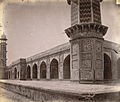Tomb of Jahangir
مقبرۂ جہانگیر | |
 | |
 | |
| 31°37′21″N 74°18′12″E / 31.6225°N 74.3032°E | |
| Location | Lahore, Pakistan |
|---|---|
| Type | Mausoleum |
| Completion date | 1637 |
The Tomb of Jahangir (
Location
The tomb is located in
Background

The tomb was built for Emperor Jahangir, who ruled the Mughal Empire from 1605 to 1627
History


Though contemporary historians attribute the construction of the tomb to Jahangir's son Shah Jahan.[8] Construction started in 1627,[3] requiring ten years for completion,[9] and cost Rs 10 Lakh.[8][7]
Repair works were undertaken at the tomb in 1814 according to Sikh court records.
The Shahdara ensemble of monuments suffered further under British rule, when
Flooding from the nearby
Architecture


The tomb was constructed in a Mughal style influenced by
Similar to the
Exterior

In keeping with
The square-shaped mausoleum is a 22 foot tall, single-story
From the building rise four octagonal ornamental minarets projecting from each corner of the building, decorated with geometric inlaid stone. The use of minarets, absent from early Mughal commissions, reflects a renewed interest in Timurid architecture from Central Asia during the reign of Jahangir.[18] The minarets are divided into three sections, with the tomb forming the base, upon which the body of the minaret rests, called by white marble cupolas. The minarets rise to a height of 100 feet (30m).
Interior

The mausoleum building is divided into a series of vaulted compartments which are richly embellished with Mughal buon fresco. Carved jali screens admit light in various patterns facing toward Mecca.
Cenotaph
At the centre of the mausoleum is an octagonal chamber lined with carved marble in which the remains of the Mughal Emperor rest in a crypt below a cenotaph. The interior of the tomb features a white-marble
Gardens

The gardens surrounding the tomb are vast, and laid out in the Persian Chahar Bagh, or
Layout
The mausoleum is set in a large quadrangle with gates facing each of the cardinal directions. Entry to the quadrangle is via the western edge through the
Conservation
The site is protected by the Federal Antiquities Act 1975,
Numismatics and philately
The tomb was featured on the 1000 Rupee note until 2005. Pakistan issued a postage stamp in 1954 to commemorate Emperor Jahangir mausoleum.
Gallery
-
The Emperor's cenotaph is located in a solemn inner chamber.
-
The tomb is surrounded by a Persian-style Paradise garden.
-
Jehangir's cenotaph is richly embellished with intricate inlay.
-
Entry to the mausoleum is through the Akbari sarai.
-
A view of the mausoleum's exterior embellishments and architectural features.
-
Even the mausoleum's roof is decorated with mosaic tile-work.
-
Close up view of the intricately inlaid marble on Jehangir's cenotaph
-
The cenotaph of the Emperor is located in the centre of the mausoleum.
-
The outer perimeter of the complex features a large entry gate known as Bara Darwaza that leads to the Akbari Sarai.
-
Bases of the minarets feature fine pietra dura detail.
-
"Illumined Grave of His Majesty, Asylum of Pardon: Emperor Nur-ud-din Muhammad Jahangir, 1037 AH"
-
Walls surrounding the tomb
-
Pietra dura detail
-
The minarets at the tomb are capped by white marble cupolas
-
Façade of Jahangir's Tomb in 1880.
-
Close-up of pietra dura detail.
-
Fresco in vestibule of tomb chamber
-
Fresco in vestibule of tomb chamber
-
Glazed tile kashi inlay in mausoleum verandah
See also
- Humayun's Tomb in Delhi
- Tomb of Akbar the Greatin Agra
References
- ^ Wiki Loves Monuments: Top 10 pictures from Pakistan are here!
- ^ "Tombs of Jahangir, Asif Khan and Akbari Sarai, Lahore". UNESCO World Heritage Centre. Retrieved 2013-12-03.
- ^ a b c d "Jahangir's tomb". Oriental Architecture. Retrieved 13 March 2015.
- ISBN 9789693507188. Retrieved 14 September 2017.
- ISBN 9780670083039. Retrieved 14 September 2017.
- ^ "Visiting the sub-continent's rebellious prince". Pakistan Today. Retrieved 13 March 2015.
- ^ a b c "Jahangir's Tomb". Visit Lahore. Retrieved 2020-08-23.
- ^ a b c "Jahangir's Tomb". UAL Berta. Archived from the original on 31 March 2016. Retrieved 13 March 2015.
- ^ "Tomb of Jahangir". Journal of Asian Civilisations. 24 (1). Taxila Institute of Asian Civilisations. 2001. Retrieved 14 September 2017.
- ^ ISBN 9780884022350. Retrieved 14 September 2017.
- ^ a b c d e f g h Rogers Kolachi Khan & Associates Pvt. Ltd. (February 2011). "Site Conservation Assessment Report: Jahangir's Tomb Complex, Lahore, Pakistan" (PDF). Global Heritage Fund. Global Heritage Fund. Retrieved 14 September 2017.
- ^ ISBN 9789693510478.
- ISBN 9781780429939. Retrieved 14 September 2017.
- ISBN 9788120802254. Retrieved 14 September 2017.
- ISBN 9788120608535. Retrieved 14 September 2017.
- ^ ISBN 9780143065432.
- ^ "The Tomb of Emperor Jehangir". Dawn. 20 August 2013. Retrieved 17 December 2016.
- ^ ISBN 9781119068570. Retrieved 14 September 2017.
- ISBN 9781784530877.
- ISBN 978-0-88402-235-0.
- ISBN 978-0-14-196655-7.
- ^ a b "Jahangir's Tomb". Asian Historical Architecture.
- ISBN 9788189995102. Retrieved 14 September 2017.
- ^ "Jahangir's Tomb". Lahore Sites of Interest. Archived from the original on 31 March 2016. Retrieved 17 December 2016.
- ^ "Tentative Lists". UNESCO. Retrieved 14 September 2017.
External links
![]() Media related to Tomb of Jahangir at Wikimedia Commons
Media related to Tomb of Jahangir at Wikimedia Commons
- SN Bukhari (2010-06-24). "Tomb of Jahangir Lahore". YouTube. Archived from the original on 2021-12-19. Retrieved 2013-12-07.
- Pakistan's PhotoBlog - Snaps of Jahangir's Tomb Archived 2015-12-29 at the Wayback Machine
- Photograph of the left side of the mausoleum
- Conservation of the mausoleum Archived 2016-10-11 at the Wayback Machine



















